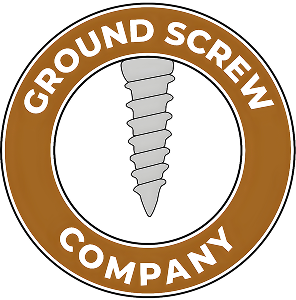Introduction
Ground screws are quickly becoming the preferred foundation solution across industries like solar energy, modular construction, fencing, and signage installations. Unlike traditional concrete foundations, ground screws offer faster installation, minimal soil disruption, and a more sustainable alternative to heavy excavation.
However, to ensure their long-term durability and reliability, rigorous quality tests are conducted. At Ground Screw Company (GSC), we perform three key tests that validate the performance of our ground screws:
- Pull-Out Test – Evaluates resistance to vertical forces.
- Lateral Test – Measures stability against sideways movement.
- Compression Test – Assesses load-bearing capacity.
These tests simulate real-world conditions, ensuring that ground screws provide unmatched stability for a variety of applications. Let’s dive deeper into each quality test and understand its significance.
1) Pull-Out Test – Evaluating Uplift Resistance
The Pull-Out Test is designed to measure a ground screw’s ability to resist vertical tension forces pulling it out of the ground. This is crucial for structures exposed to high wind loads, soil shifts, and heavy external forces.
Why is the Pull-Out Test Important?
- Prevents Foundation Uplift: Ensures that ground screws remain firmly in place despite external pulling forces.
- Ensures Long-Term Structural Stability: Particularly important for solar panel foundations and fencing installations, where high winds or uneven terrain can create strong upward forces.
- Determines Soil Compatibility: Different soil types impact ground screw performance. The pull-out test evaluates whether the soil can support the expected load without failure.
How is the Pull-Out Test Conducted?
- A ground screw is installed at the required depth in a test field.
- A hydraulic pull machine is attached to the screw to exert an upward force.
- The force is gradually increased while sensors measure the displacement and resistance of the screw.
- The test continues until the screw reaches its maximum resistance point or fails
Real-World Applications
- Solar Energy Projects: Prevents panels from shifting due to high wind pressure.
- Signage & Billboards: Ensures advertising structures remain upright.
- Temporary & Permanent Fencing: Helps fences stay anchored in loose soil
At Ground Screw Company, we ensure our ground screws undergo stringent pull-out tests to guarantee maximum holding strength.
2) Lateral Test – Measuring Stability Against Horizontal Forces
Ground screws often face lateral (sideways) forces due to wind pressure, seismic activity, or shifting soil. The Lateral Test measures a screw’s ability to withstand these forces, ensuring its stability even in extreme conditions.
Why is the Lateral Test Important?
- Ensures Stability in Windy Conditions: Critical for solar farms and wind energy foundations, where lateral forces are common.
- Reduces Risk of Structural Tilting: Prevents structures from shifting sideways, which can compromise integrity.
- Essential for Seismic Resistance: Provides additional safety in earthquake-prone regions.
How is the Lateral Test Conducted?
- The ground screw is installed at its operational depth in a test field.
- A hydraulic press is used to apply a sideways force at various points along the screw shaft.
- Sensors measure the amount of lateral movement and at what point failure occurs.
- The test evaluates the maximum force the screw can withstand before it shifts or bends
Real-World Applications
- Solar Panel Foundations: Prevents panel misalignment due to wind or shifting ground.
- Prefab & Modular Construction: Ensures portable structures remain secure on uneven ground.
- Road & Traffic Signage: Helps signs withstand roadside wind turbulence.
By passing Ground Screw Company’s Lateral Test, our ground screws provide unmatched resistance against side forces, ensuring long-term reliability.
3) Compression Test – Verifying Load-Bearing Strength
The Compression Test assesses a ground screw’s ability to handle downward pressure from the structures it supports. This test ensures that heavy loads can be accommodated without risk of sinking or deformation.
Why is the Compression Test Important?
- Guarantees High Load-Bearing Capacity: Essential for solar farms, modular homes, and commercial buildings.
- Prevents Ground Settlement: Ensures that the structure remains level over time.
- Provides a Strong, Durable Foundation: Necessary for permanent installations where safety is a priority.
How is the Compression Test Conducted?
- A heavy vertical load is placed on the installed ground screw.
- The force is gradually increased to simulate real-world weight conditions.
- Sensors monitor screw displacement, bending, and structural integrity.
- The test determines the maximum load the ground screw can support.
Real-World Applications
- Solar Panel Farms: Ensures screws can support heavy mounting structures.
- Temporary & Permanent Housing: Guarantees that modular buildings remain stable.
- Decking & Outdoor Structures: Prevents deck posts from sinking over time.
By undergoing Ground Screw Company’s Compression Test, our ground screws prove their ability to support large structures safely.
Why Quality Testing Matters for Ground Screws?
Choosing a ground screw that has undergone comprehensive quality testing ensures:
- Long-lasting durability in all soil types.
- Minimal maintenance and reduced replacement costs.
- Increased safety for solar installations, modular buildings, and fencing projects.
How Do GSC Ground Screws Compare?
| Test Type |
GSC Ground Screws |
Standard Market Screws |
| Pull-Out Test |
Passed High Resistance Test |
Varies by soil type |
| Lateral Test |
Strong Stability in Wind & Seismic Conditions |
May tilt under extreme pressure |
| Compression Test |
High Load-Bearing Strength |
May sink under heavy weight |
Final Thoughts: Invest in Quality for Long-Term Performance
When investing in ground screws for solar projects, construction, or fencing, quality testing should be a top priority. At Ground Screw Company (GSC), we conduct rigorous pull-out, lateral, and compression tests to ensure:
- Maximum durability
- Stability in all soil conditions
- Superior load-bearing capacity
 GET A QUOTE
GET A QUOTE